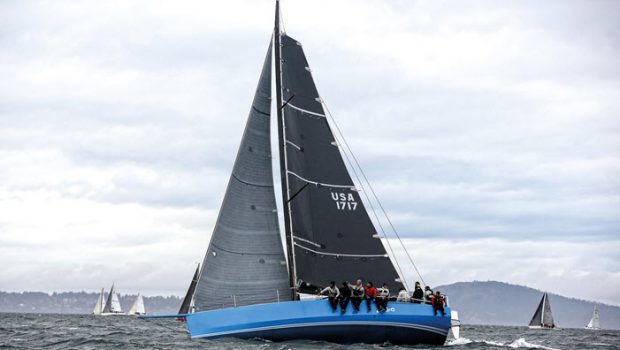Righting moment augmentation in modern sailing yachts
Published on February 19th, 2020
In the last year, two major events in the Pacific Northwest crowned champions that sailed vessels utilizing a system of enhanced or assisted ballast—Team Angry Beaver won Race to Alaska aboard a canting-keel Schock 40; and the water-ballasted Riptide 41, Blue, topped the fleet of the biggest, fastest boats in a variety of conditions throughout the Van Isle 360.
To help us better understand these systems, world-renowned Pacific Northwest designer and the mind behind Blue, Paul Bieker, provides this report in the February 2020 issue of 48° North:
Ultralight Displacement Boats (ULDBs) started making inroads into the sailing scene in the 1970s. This was partially driven by the new cored composite structures and improved engineering methods that allowed yacht structures to be significantly lighter than they had previously been.
The first modern ULDBs that I am aware of were designed by John Spencer in New Zealand–the classic example being Infidel (renamed Ragtime). Incidentally, she was the first ULDB that I watched glide by us as I trimmed the blooper on a death-rolling two tonner back in the late 70s.
The Santa Cruz scene followed the Kiwi lead, with designers like Bill Lee creating boats that excelled in the California downwind classic races such as TransPac. These boats were exceedingly fast downwind but pretty slow upwind in most conditions.
As time went on, Bill Lee, George Olsen, and Carl Schumacher produced smaller ULDBs for the wider sailing public. These boats continued the pattern of downwind strength and upwind weakness established by their predecessors (with Carl Schumacher using more powerful hull shapes to improve the situation somewhat).
Once sailors got a feel for the excitement of sailing a ULDB downwind, it was a hard thing to walk away from. The answer to making a ULDB get around a windward-leeward race course in reasonable form is to design the boats with a bit more hull form stability (more beam) than early ULDBs and to sail the boats with extra crew members that are only there as moveable ballast.
Nowadays, most of the performance keelboats on the race course are sailed with a significant proportion of their crew acting as self-propelled units of ballast. Full report.









 We’ll keep your information safe.
We’ll keep your information safe.